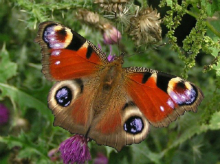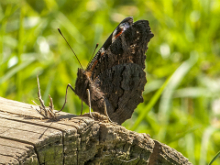
Widespread and common


Distribution and Status
The Peacock is widely distributed in the two counties. In some years, there is some evidence of migration from Europe which may partly account for the fluctuating numbers although generally abundance has declined since the mid 1990s. Recently, some warm summers have produced a partial second brood in the latter half of September supported by reports of full-grown larvae at some sites in August
Habitat Requirements
Anywhere except on the highest ground but more common in wooded areas
Larval Foodplants
Common Nettle Urtica dioica
Adult Food Sources
Buddleia Buddleja davidii, Teasel Dipsacus fullonum, Common Fleabane Pulicaria dysenterica. In the spring, it is often found feeding on Willow Salix sp. and Blackthorn Prunus spinosa blossoms
Behaviour/Observation notes
It is a very conspicuous butterfly which usually has its wings open when basking or feeding so there should be ample opportunities to take photographs although care should be taken when approaching any such specimen. The males are territorial often in woodland rides or along hedgerows in the spring. Molehills in sheltered situations may attract a courting or mating pair. In the late summer and autumn much time is spent feeding to fatten up reserves for the winter hibernation

Life History
The Peacock produces one generation a year but in warm summers a partial second brood may occur as noted above. Overwintering adults often appear on the first warm days of the year, even early as January and continue flying until early June. The new brood emerges in July and numbers reach a peak often in the last week of July but the butterflies usually go into hibernation by the middle of August although some will awake on warm days until late autumn. From May, females lay batches of eggs under leaves of tall nettle plants in sunny, sheltered places. The black larvae emerge in late May and June forming silken webs over the leaves within which they feed. Before the end of June pupae are usually formed attached to a stem away from the foodplant
Further information
Photo gallery
Branch Annual Report (2022)
UK distribution map
Full list of larval hostplants (Nymphalidae)
Stevenage butterflies - additional notes